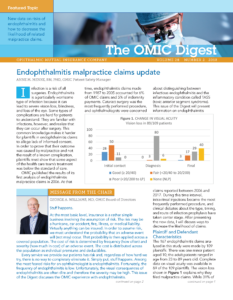Message from the Chair
GEORGE A. WILLIAMS, MD, OMIC Board of Directors
Stuff happens.
At the most basic level, insurance is a rather simple business involving the assumption of risk. The risk may be a hurricane, car accident, fire, illness, or medical liability. Virtually anything can be insured. In order to assume risk, we must understand the probability that an adverse event will (not may) occur. That probability is then applied across a covered population. The cost of risk is determined by frequency (how often) and severity (how much in cost) of an adverse event. The cost is distributed across the population as individual premiums and deductibles.
Every service we provide our patients has risk and, regardless of how hard we try, there is no way to completely eliminate it. Simply put, stuff happens. Among the most feared risks for an ophthalmologist is endophthalmitis. Fortunately, the frequency of endophthalmitis is low. Unfortunately, the visual consequences of endophthalmitis are often dire and therefore the severity may be high. This issue of the Digest discusses the OMIC experience with endophthalmitis.
The low frequency of endophthalmitis sometimes leads to surgeons’ complacency or even denial. We all know the signs and symptoms of endophthalmitis, but we may think or hope that the post-procedure inflammation we see is sterile. Since endophthalmitis is a recognized complication, when it is recognized and treated in a timely manner, OMIC rarely loses a lawsuit regardless of outcome. Such cases are vigorously defended. Conversely, we almost always lose when the diagnosis or treatment is delayed.
Although we can’t eliminate the risk of endophthalmitis, we must do all we can to minimize the risk. Attention to sterile technique has always been critical, but as Anne Menke notes, so is patient engagement. An engaged, educated patient is our first line of defense.
The face of endophthalmitis is changing. Historically, the most common cause of endophthalmitis has been cataract surgery. With the explosion of intravitreal injections, that is certain to change. We know from the IRIS Registry that the incidence of endophthalmitis following both cataract surgery and intravitreal injection is approximately 1 in 2,000 procedures.
However, injections far exceed cataract surgery and continue to grow. Already the IRIS Registry has recorded over 10,000,000 injections. The power of such large numbers provides OMIC with a potent risk management tool. That is why OMIC has been a strong supporter of the IRIS Registry.
This support is another example of the unique synergy between OMIC and the American Academy of Ophthalmology. Of course, this is one of the many advantages OMIC has over other malpractice carriers; just what you would expect from a company of ophthalmologists for ophthalmologists. When stuff happens, OMIC will be there for you.
2018 Members Report
 We recently published our 2018 Members Report. Policyholders should receive their copy within a few weeks. Our specialty and our industry are changing fairly rapidly. We discuss your company’s leadership in an unsteady environment.
We recently published our 2018 Members Report. Policyholders should receive their copy within a few weeks. Our specialty and our industry are changing fairly rapidly. We discuss your company’s leadership in an unsteady environment.
In this report:
MESSAGE FROM THE CHAIR George Williams, MD discusses the changes occurring in our specialty.
MESSAGE FROM THE CEO Tim Padovese celebrates another stand-out year by announcing some big news.
FINANCIAL HIGHLIGHTS Robert Wiggins MD highlights two OMIC financial and operational metrics that show our superior performance compared to multispecialty carriers.
Endophthalmitis education for patients
ANNE M MENKE, RN, PhD, OMIC Patient Safety Manager
A number of plaintiffs who filed a claim against OMIC insureds after developing endophthalmitis inadvertently delayed their own diagnosis and treatment. They either did not report symptoms or chose to delay seeing a retinal specialist. Delay in initiating treatment can lead to a worse outcome. Our experts reviewing such claims try to determine whether the defendant could have handled the situation better.
Q. We provide each patient instructions on when to call us after surgery. My patient did not follow these instructions. What could I have done differently?
A. Plain-language experts feel that patients need to see the most important information first. They are most likely to read key instructions that are placed at the beginning of the document. The instructions need to be short, simple, and clear. The printed documents from your EHR may not be easy for patients to read, and the information they need the most may be hard to find. Instead, use a short document that starts like this: “Patients can have problems after eye surgery (or an eye injection). We need your help to watch for them. Please call our office right away if you have these problems: 1) Pain that is getting worse, or 2) Vision that is getting worse.” You can provide information about the normal postoperative course and the time of the follow-up appointment after you have discussed vision-threatening symptoms that need to be reported to you. As an alternative, some ophthalmologists send short post-procedure instructions via text to patients who choose to receive them; and encourage the patients to text back questions or concerns.
Q. My patient called to report pain after cataract surgery. I wanted her to go see a retina specialist right away, but there is no specialist in our town. She was not willing to drive one hour to be examined at the academic center. When she sued me, she said I never told her she needed urgent care. How could I have explained this better?
A. Providing care over the telephone is challenging. Obtaining “informed refusal” this way is even more difficult. When patients indicate that they will not follow your medical advice, you need to take steps to ensure that they understand the possible consequences. You might say something like this: “Mrs. Harrison, I understand that your husband does not want to drive for one hour in the dark. I am very worried about your eye. You could have a serious infection. If the infection is not treated right away, you could lose vision. You might even go blind in that eye.” To confirm that patients understand your warning, ask them to repeat it back to you: “I want to make sure that I have explained why I am worried. Could you please tell me what might happen if you don’t get care right away?” You might also ask if an adult child, neighbor, or volunteer from a local organization could drive the patient to the appointment. Be sure to document the conversation as soon as possible.
Q. I heard that during the informed consent discussion, I should point out complications for which the patient is at increased risk? Is that true?
A. Yes. Such a discussion might have helped patients in the study who had poorly controlled diabetes mellitus or were taking immunosuppressant medications. You might counsel a patient this way: “I want to talk to you about how your cancer treatment might affect you after your eye surgery. Surgery can cause infection. Your cancer treatment will make it harder for your body to fight an infection. So it’s important that you call me right away if you have any problems after surgery. Here is the list of problems I want to know about.”
Endophthalmitis outbreak following intravitreal injections
Ryan M. Bucsi, OMIC Claims Manager
On 1/26/16 and 1/27/16, a non-OMIC ophthalmologist at an OMIC-insured practice injected 8 patients, aged 64 to 94, with Avastin or Eylea to treat neovascular age-related macular degeneration. The patients’ visual acuities in the eyes to be injected ranged from 20/25 to 20/150. The ophthalmologist added dexamethasone to the anti-VEGF medication. The dexamethasone was withdrawn from the same single-dose vial for all 8 patients. The ophthalmologist used the needle included with the Eylea kit to puncture the dexamethasone vial after puncturing the Eylea vial. The prepackaged Avastin needle was used to puncture the dexamethasone vial and then was used again to inject the patients. Betadine and Navobay Hypochlorous solution was used to prep for the treatment. Following the injections, the ophthalmologist pressed on each of the treated eyes with his bare finger to check the pressure. Each patient returned within 2 to 3 days complaining of decreased vision and pain and was diagnosed with endophthalmitis. Despite treatment, each patient lost visual acuity. The visual acuities post-injection ranged from 20/200 to hand motion.
Analysis
OMIC’s retained expert opined that both the non-OMIC ophthalmologist and the OMIC-insured practice failed to meet the standard of care. The expert criticized the following aspects of the care. None of the consent forms for Avastin and Eylea mentioned anything about the addition of dexamethasone. The records were sloppy and inaccurate with no specific operative note. Adding steroids to an anti-VEGF medication was unnecessary: there are no clinical trials demonstrating that adding steroids increases the effectiveness of Avastin or Eylea. Puncturing a single-dose vial multiple times with the needle from the Avastin or Eylea, and then using the same needle to inject the patient, was beneath the standard of care. Pressing on the eye with a bare finger after injecting the anti-VEGF medication to check the pressure could have contributed to the infection.
The expert also raised concerns about the drugs used to anesthetize the eye. The patients received subconjunctival injections of Marcaine and Lidocaine. It is unclear why Marcaine was used, since the anti-VEGF procedure only lasts a few minutes. The drugs were presumably drawn from separate vials using the same syringe, another possible source of infection. The expert also questioned the pre-injection preparation using both Betadine and Navobay Hypochlorous solution. There is nothing in the literature to support the use of Hypochlorous solution before an intravitreal injection. The ophthalmologist should have just used Betadine.
The expert also criticized the role the staff at the OMIC-insured practice was asked to play. The technicians—not the physician—obtained informed consent for the injections. In addition, the technicians at times drew up the dexamethasone from the single-use vial and added it to the Avastin or Eylea, compounding the drug when the MD should have done so. The technicians, like the ophthalmologist, did not wear gloves when handling the patients. After washing or sanitizing their hands, the ophthalmologist and the technicians adjusted the chair numerous times, then touched the patient, which was another possible source of contamination.
Takeaway
Seven of the eight patients filed lawsuits against the ophthalmologist and practice. From OMIC’s perspective, these cases were indefensible and needed to be settled versus trying each of these 7 cases in front of 7 different juries. OMIC felt that the treatment by the non-OMIC insured ophthalmologist was likely the source of this endophthalmitis outbreak, especially since he touched the eyes following each injection with his bare hand. However, there were multiple potential sources of endophthalmitis in these cases, including the way the dexamethasone was added to the anti-VEGF medications. Therefore, OMIC settled these 7 cases on behalf of our insured entity. The multispecialty carrier for the ophthalmologist placed the blame for this endophthalmitis outbreak solely on the OMIC-insured technicians and opined that the ophthalmologist met the standard of care. The other carrier also questioned the credentials of our retained expert and championed its insured as a much more qualified expert in the field of ophthalmology. Eventually, the multispecialty carrier settled the cases on behalf of the ophthalmologist.
Responding to reviews on social media
 Our Risk Management Hotline routinely receives calls from insureds asking how they should respond to reviews on social media and physician rating sites. Whether the reviews are positive or negative it is important to have a planned approach for responding.
Our Risk Management Hotline routinely receives calls from insureds asking how they should respond to reviews on social media and physician rating sites. Whether the reviews are positive or negative it is important to have a planned approach for responding.
A primary concern with responding through these sites is maintaining privacy. A practice can be subject to a HIPAA violation if it responds to a reviewer, and in the process, Protected Health Information (PHI) is shared. Even acknowledging that the reviewer is a patient can trigger an unauthorized HIPAA breach.
OMIC recommends the following steps be taken in responding to reviews:
- Investigate what happened. Conduct an internal review.
- Thank the reviewer for the feedback online. Underscore the importance of feedback and your commitment to quality care. Invite the reviewer to contact your office to discuss the matter privately due to HIPAA privacy concerns. Here is an example response: “Thank you for your feedback. I take patient satisfaction seriously. In order to protect a patient’s privacy, we prefer to handle a situation like this offline. Please contact our office (phone).”
- Reach out to the reviewer privately. Listen first and formulate a plan to respond. Consult with Risk Management for help
- Appeal to the publisher of the site. Does reviewer’s comments violate the site’s policies? If so, request the review be removed.
- Develop a written social media policy for your practice so there is a consistent process for responding to reviews.
Here are additional resources to help you:
The following organizations offer additional guidelines on responding to social media reviews. Click on these links:
Federation of State Medical Boards (FASB)
Contact the OMIC Hotline for confidential assistance on this topic and any risk management issue. We’re here to help!
Phone: 800.562.6642 (Press 4)
Email: riskmanagement@omic.com







